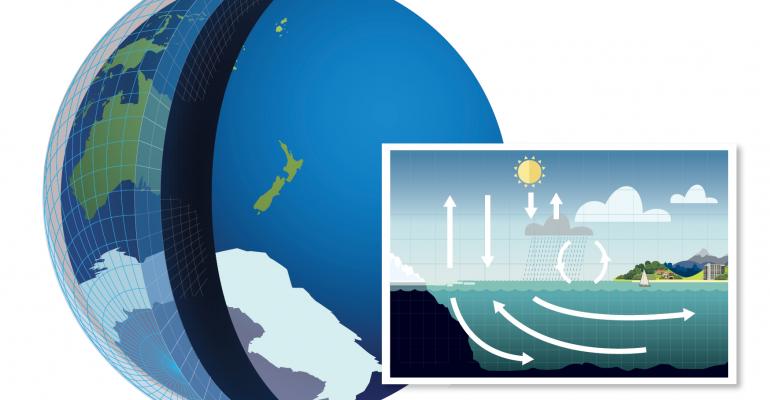- AUTHORNew Zealand's Next Top Model
- November 29 2016
New Zealand’s Next Top Model

The development of a New Zealand-based Earth System Model represents a significant investment to better predict New Zealand’s climate, and therefore to make more informed decisions for the future. We asked Dr Olaf Morgenstern, who leads both the Earth System Model and Prediction Programme and the “Capability” project within the Deep South Challenge, how the project has been developing.
What does the Capability project involve?
The Capability project is about coordinating, supporting, maintaining, and to some extent operating the New Zealand Earth System Model (NZESM). As such, it occupies a central role in the Earth System Modelling & Prediction (ESMP) programme of the Deep South National Science Challenge. Thus far, the project has focussed on two roles:
The first is to bring in, install, and test versions of the Hadley Centre Global Environment Model (HadGEM) which the NZESM will be based on.
The other role is to support users. In the future, as the other, more scientifically oriented projects gain momentum, the project will also coordinate code contributions from these projects.
What will this enable us in New Zealand to do that we can’t do now?
In the future we will have an Earth System Model of our own which we will use to produce simulations of past, present, and future climate. We have never had such a capability before and have had to rely solely on international modelling efforts for global climate projections. These are subject to some well-documented weaknesses, particularly in the Southern Hemisphere. A desire to get involved in model development to tackle these deficiencies, tapping into local expertise in high-latitude (i.e. Southern-Ocean and Antarctic) climate physics, was a motivating factor for the New Zealand Government to give the Deep South Challenge the remit that it now has.
You’ve been overseas to meet with international counterparts and collaborators – how will we work with them in the future?
Our lead overseas partner is the UK Met Office. The Met Office is a world-leading climate modelling centre, having contributed to all five Assessment Reports published by the Intergovernmental Panel on Climate Change (IPCC) since 1990. NIWA has an established relationship with the Met Office, having used their weather and climate models since the 1990s. Hence the Deep South Challenge decided to base the NZESM on the UK Earth System Model (UKESM). Development of this model is now shared between the Met Office and several partners, including the Deep South Challenge. Jonny Williams, Olaf Morgenstern, and Vidya Varma visited the Met Office in November 2015 and April 2016, to meet with Met Office colleagues and learn about the model, their plans, and current projects.
You have a new person in the team where are they from, and what is their role?
The new team member is Fraser Dennison who is in the final assessment stage of completing his PhD in climate model evaluation at the University of Canterbury. He is originally from Timaru; his background is in engineering and physics. As a PhD student, he was jointly supervised by Adrian McDonald, the newly appointed Processes & Observations programme leader, and myself. Fraser’s topic was the influence of ozone depletion and other factors on Southern-Hemisphere climate. In his current project for the Deep South Challenge, he is further developing stratospheric chemistry in the NZESM, with the hope to improve the simulation of ozone in the model. Such an improved simulation may result in better representation of the role of ozone depletion on the climate of our region.
Are we on track? What are the challenges?
Yes, we are generally on track regarding the technology of hosting and availability of the model. Over the course of the last year, the NZESM user group has been established; it is set to grow further, particularly outside NIWA. A challenge is that our supercomputer is quite small; we are looking forward to seeing it replaced over the course of 2017. We have not yet contributed any substantial code changes to the UKESM/NZESM – it takes time to get established, to understand the details of the model formulation, and then to devise ways to improve it.
What do you hope we will achieve with the NZESM? What are the implications for NZ decision makers?
Our hope is to develop a leading internationally used climate modelling tool, improving climate information available in New Zealand, both at the global and the regional scale. For NZ decision makers this will hopefully mean access to more reliable climate projections. There is a lot of regional detail in these projections. We anticipate that we will to provide localised climate projections to a range of decision makers, e.g. a kiwifruit grower in Tauranga deciding on future fruit varieties, or a council investing in drainage in a low lying coastal town. They will also have access to experts with hands-on experience in producing these simulations who can give them advice on the assumptions and uncertainties associated with these projections. Also quite generally, this activity will considerably raise NZ’s profile in the international climate modelling scene.
Read: First Year Anniversary for climate modeller Dr Jonny Williams